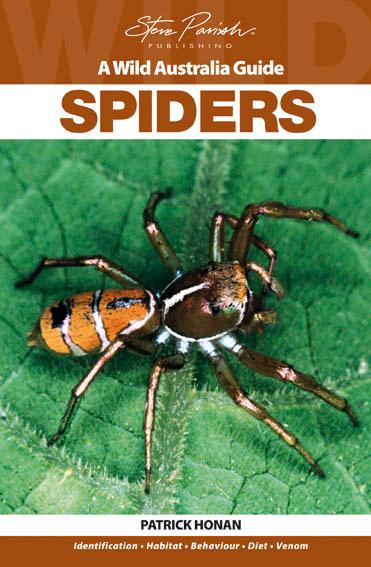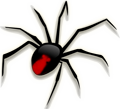Australian Bronze Jumping Spider
Helpis minitabunda
 NEW There's an alternative version of this page at the new website www.ark.net.au/australian-bronze-jumping-spider.html NEW There's an alternative version of this page at the new website www.ark.net.au/australian-bronze-jumping-spider.html Other Names: Threatening Jumping Spider
Family: Salticidae (Jumping Spiders). The world's most diverse and abundant spider family, with over 500 described genera and 5000 described species, which is more than 13% of all described spiders.
Size: Body 11-12 mm
Distribution:
Habitat:
References: Whyte and Anderson
About the Australian Bronze Jumping SpiderSome other jumping spiders are shown below the Australian Bronze Jumping Spider. Jumping spiders are among the most visually attractive of all spiders.
Note that dead spiders usually fade in colour, so nearly all the spiders will look blacker or darker in colour in real life than they do in the photos of dead spiders from the museum. 
Photo taken at Australian Museum, Sydney. High Resolution 2572 x 2000.

Source: Wikipedia. Public domain photo by USGS Bee Inventory and Monitoring Lab. Jumping Spider (family Salticidae), species unknown. Beltsville, Maryland, USA. High Resolution 5616 x 3744.

Source: Wikipedia. Public domain photo by USGS Bee Inventory and Monitoring Lab. Jumping spider, species unknown. From Upper Marlboro, Maryland, USA. High Resolution 3816 x 2544.

Source: Wikipedia. Public domain photo by USGS Bee Inventory and Monitoring Lab. Christmas Lights Jumping Spider from the Dominican Republic, species unknown, but surprisingly marked with fluorescent scales. High Resolution 4647 x 2919.

Source: Pixabay. Public domain photo. Jumping Spider, species and country unknown. High Resolution 1920 x 1440.

Source: Pixabay. Public domain photo. Jumping Spider, species and country unknown. High Resolution 1920 x 1470.

Source: Pixabay. Public domain photo. Cute Jumping Spider, species and country unknown. High Resolution 1920 x 1280.
Recommended Reading
|
 Spiders: A Wild Australia Guide, by Patrick Honan.
Spiders: A Wild Australia Guide, by Patrick Honan. 96 pages. This is a smaller spider guide showing the most well known spiders and then a few more. From the publisher, "Australia is home to more than 2000 known species of spiders - and it is estimated that four times that number actually exist in this country waiting to be discovered! Within the ranks of Australian spiders we find some of the most uniquely interesting and skilled creatures of the animal world, along with a few potentially-deadly species and even more harmless individuals with fearsome reputations. Love them or loathe them, spiders are a part of everyday life, and this Steve Parish WILD AUSTRALIA GUIDE provides an insight into the lives of some of these often-reclusive visitors to our gardens, homes and wild places. From how to identify them and where they live, to their unique skills and behaviours, this guide lets you get up close to some of the most common Australian spiders. Who knows? You may even find some of these fascinating creatures living right under your nose."
| See Also
Australian Mammals
Australian Birds
Australian Reptiles
Australian Frogs
Australian Fish
Australian Wild Plant Foods
Return to Australian Spiders
Return to Site Map
australian high jumping photo resolution species spider spiders
Content is copyright © Survival.org.au 2005-2026 All Rights Reserved. Terms of Use. Definitely read the disclaimer before trying anything from this website, especially including the practices and skills. This website uses affiliate links – this doesn't cost you any more, but I get a commission on purchases made through the website. As an Amazon Associate I earn similarly from qualifying purchases.
|









